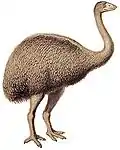Geranoididae
Geranoididae is a clade of extinct birds from the early to late Eocene and possibly early Oligocene of North America and Europe. These were mid-sized, long-legged flightless birds.[1][2][3][4][5] Recent research shows that these birds may actually be palaeognaths related to ostriches.[6]
| Geranoididae Temporal range: Eocene | |
|---|---|
| Scientific classification | |
| Domain: | Eukaryota |
| Kingdom: | Animalia |
| Phylum: | Chordata |
| Clade: | Dinosauria |
| Class: | Aves |
| Infraclass: | Palaeognathae |
| Family: | †Geranoididae Wetmore, 1933 |
| Genera | |
| |
Classification
It is rather unambiguous that geranoidids are either part of or stem representatives of Gruoidea, the clade that includes modern cranes, limpkins and trumpeters, though their precise relationship varies among studies, some recovering them as sister taxa to another clade of flightless ratite-like birds, the eogruiids. The most recent consensus appears to be that geranoidids are outside of Gruoidea, with eogruiids being more closely related to modern cranes.[4] However, Mayr (2019) argued that close affinities between Geranoididae and the palaeognathous family Palaeotididae are at least as well supported as the classification of geranoidids into the Gruiformes.[6]
Taxonomy
The exact number of genera and species are also somewhat controversial. For instance, a recent study recovers Geranoides as possibly synonymous with Palaeophasianus and Eogeranoides as possibly synonymous with Paragrus.[4]
Paleobiology
Most geranoidids appear to have been flightless, with long legs and short wings, and presumably with herbivorous habits, giving them a profile and lifestyle similar to that of modern ratites. Most if not all of them were forest dwellers, a lifestyle also present in contemporaneous ratites such as Palaeotis and Remiornis.[7] While competition and lack thereof between ratites and eogruiids has been examined extensively,[8][9][10] niche partitioning between geranoidids and ratites has currently not, in spite of factors like geranoidids being most common in North America, where there are no ratites, or the fact that some European ratites were carnivorous.[5][11]
Paleoecology and distribution
Geranoidids are most common in Eocene fossil sites in North America, particularly in the Willwood Formation were up to six species are known. Galligeranoides occurs in the Eocene of France in association with another flightless bird, Gastornis, potentially indicating that geranoidids took advantage of land bridges to arrive to Europe.[3] However, Mayr (2019) considered Galligeranoides to be a member of Palaeognathae closely related to Palaeotis, and formally transferred Galligeranoides from the family Geranoididae to the family Palaeotididae. This transfer restricts the fossil record of the family Geranoididae to North America.[6]
References
- Cracraft, Joel (August 27, 1969). "Systematics and evolution of the Gruiformes (Class, Aves). 1. The Eocene family Geranoididae and the early history of the Gruiformes". American Museum Novitates (2388): 1–41. hdl:2246/2598.
- Cracraft, Joel (1973). "Systematics and evolution of the Gruiformes (Class Aves). 3. Phylogeny of the suborder Grues". Bulletin of the American Museum of Natural History. 151: 1–127. hdl:2246/597.
- Bourdon, Estelle; Mourer-Chauviré, Cécile; Laurent, Yves (2016). "Early Eocene birds from La Borie, southern France". Acta Palaeontologica Polonica. 61 (1): 175–190. doi:10.4202/app.00083.2014.
- Mayr, Gerald (2016). "On the taxonomy and osteology of the Early Eocene North American Geranoididae (Aves, Gruoidea)". Swiss Journal of Palaeontology. 135 (2): 315–325. doi:10.1007/s13358-016-0117-2. S2CID 87692869.
- Gerald Mayr (2009). Paleogene Fossil Birds
- Mayr, Gerald (2019). "Hindlimb morphology of Palaeotis suggests palaeognathous affinities of the Geranoididae and other "crane-like" birds from the Eocene of the Northern Hemisphere". Acta Palaeontologica Polonica. 64 (4): 669–678. doi:10.4202/app.00650.2019.
- Buffetaut, Eric; Angst, Delphine (November 2014). "Stratigraphic distribution of large flightless birds in the Palaeogene of Europe and its palaeobiological and palaeogeographical implications". Earth-Science Reviews. 138: 394–408. Bibcode:2014ESRv..138..394B. doi:10.1016/j.earscirev.2014.07.001.
- Kurochkin, E.N. 1976. A survey of the Paleogene birds of Asia. Smithsonian Contributions to Paleobiology 27:75-86.
- Kurochkin, E.N. 1981. New representatives and evolution of two archaic gruiform families in Eurasia. Transactions of the Soviet-Mongolian Paleontologial Expedition 15:59-85.
- Zelenkov, Nikita; Boev, Zlatozar; Lazaridis, Georgios (2016). "A large ergilornithine (Aves, Gruiformes) from the Late Miocene of the Balkan Peninsula". Paläontologische Zeitschrift. 90 (1): 145–151. doi:10.1007/s12542-015-0279-z. S2CID 131264199.
- Houde, Peter; Haubold, Hartmut (June 1987). "Palaeotis weigelti restudied: a small middle Eocene Ostrich (Aves: Struthioniformes)". Palaeovertebrata. 17 (2): 27–42.
_white_background.jpg.webp)

